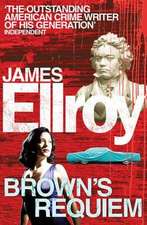A Sight For Sore Eyes
Autor Ruth Rendellen Limba Engleză Paperback – iun 2011
| Toate formatele și edițiile | Preț | Express |
|---|---|---|
| Paperback (2) | 54.17 lei 3-5 săpt. | |
| Dell Publishing Company – 29 feb 2000 | 54.17 lei 3-5 săpt. | |
| CORNERSTONE – iun 2011 | 107.17 lei 3-5 săpt. | +12.50 lei 4-10 zile |
Preț: 107.17 lei
Nou
Puncte Express: 161
Preț estimativ în valută:
20.51€ • 21.36$ • 17.33£
20.51€ • 21.36$ • 17.33£
Carte disponibilă
Livrare economică 18 februarie-04 martie
Livrare express 01-07 februarie pentru 22.49 lei
Preluare comenzi: 021 569.72.76
Specificații
ISBN-13: 9780099557159
ISBN-10: 0099557150
Pagini: 432
Dimensiuni: 131 x 202 x 32 mm
Greutate: 0.3 kg
Editura: CORNERSTONE
ISBN-10: 0099557150
Pagini: 432
Dimensiuni: 131 x 202 x 32 mm
Greutate: 0.3 kg
Editura: CORNERSTONE
Notă biografică
Ruth Rendell's many writing awards include three Edgars and the Grand Master Award from the Mystery Writers of America as well as four Golden Daggers from England's Crime Writers Association. She is also the author of Harm Done, Road Rage, The Keys to the Street, Simisola, The Crocodile Bird, and many more acclaimed novels.
She lives in England. In 1997 she was named a life peer in the House of Lords.
She lives in England. In 1997 she was named a life peer in the House of Lords.
Extras
They were to hold hands and look at one another. Deeply, into each other's eyes.
"It's not a sitting," she said. "It's a standing. Why can't I sit on his knee?"
He laughed. Everything she said amused or delighted him, everything about her captivated him from her dark red curly hair to her small white feet. The painter's instructions were that he should look at her as if in love and she at him as if enthralled. This was easy, this was to act naturally.
"Don't be silly, Harriet," said Simon Alpheton. "The very idea! Have you ever seen a painting by Rembrandt called The Jewish Bride?"
They hadn't. Simon described it to them as he began his preliminary sketch. "It's a very tender painting, it expresses the protective love of the man for his young submissive bride. They're obviously wealthy, they're very richly dressed, but you can see that they're sensitive, thoughtful people and they're in love."
"Like us. Rich and in love. Do we look like them?"
"Not in the least, and I don't think you'd want to. Ideas of beauty have changed."
"You could call it 'The Red-haired Bride.' "
"She's not your bride. I am going to call it 'Marc and Harriet in Orcadia Place'--what else? Now would you just stop talking for a bit, Marc?"
The house they stood in front of was described by those who knew about such things as a Georgian cottage and built of the kind of red bricks usually called mellow. But at this time of the year, midsummer, almost all the brickwork was hidden under a dense drapery of Virginia creeper, its leaves green, glossy and quivering in the light breeze. The whole surface of the house seemed to shiver and rustle, a vertical sea of green ruffled into wavelets by the wind.
Simon Alpheton was fond of walls, brick walls, flint walls, walls of wood and walls of stone. When he painted Come Hither outside the studio in Hanging Sword Alley he placed them against a concrete wall stuck all over with posters. As soon as he saw that Marc's house had a wall of living leaves he wanted also to paint that, with Marc and Harriet too, of course. The wall was a shining cascade in many shades of green, Marc was in a dark-blue suit, thin black tie and white shirt, and Harriet was all in red.
When the autumn came those leaves would turn the same color as her hair and her dress. Then they would gradually bleach to gold, to pale-yellow, fall and make a nuisance of themselves, filling the whole of that hedge-enclosed paved square and the entire backyard to a depth of several inches. The brickwork of the house would once more be revealed and the occasional, probably fake, bit of half-timbering. And in the spring of 1966 pale-green shoots would appear and the leafy cycle begin all over again. Simon thought about that as he drew leaves and hair and pleated silk.
"Don't do that," he said, as Marc reached forward to kiss Harriet, at the same time keeping hold of her hand and drawing her toward him. "Leave her alone for five minutes, can't you?"
"It's hard, man, it's hard."
"Tenderness is what I want to catch, not lust. Right?"
"My foot's gone to sleep," said Harriet. "Can we take a break, Simon?"
"Another five minutes. Don't think about your foot. Look at him and think about how much you love him."
She looked up at him and he looked down at her. He held her left hand in his right hand and their eyes met in a long gaze, and Simon Alpheton painted them, preserving them in the front garden of Orcadia Cottage, if not forever, for a very long time.
"Maybe I'll buy it," Harriet said later, looking with approval at the outline of her face and figure.
"What with?" Marc kissed her. His voice was gentle but his words were not. "You haven't any money."
When Simon Alpheton looked back to that day he thought that this was the beginning of the end, the worm in the bud showing its ugly face and writhing body among the flowers.
"It's not a sitting," she said. "It's a standing. Why can't I sit on his knee?"
He laughed. Everything she said amused or delighted him, everything about her captivated him from her dark red curly hair to her small white feet. The painter's instructions were that he should look at her as if in love and she at him as if enthralled. This was easy, this was to act naturally.
"Don't be silly, Harriet," said Simon Alpheton. "The very idea! Have you ever seen a painting by Rembrandt called The Jewish Bride?"
They hadn't. Simon described it to them as he began his preliminary sketch. "It's a very tender painting, it expresses the protective love of the man for his young submissive bride. They're obviously wealthy, they're very richly dressed, but you can see that they're sensitive, thoughtful people and they're in love."
"Like us. Rich and in love. Do we look like them?"
"Not in the least, and I don't think you'd want to. Ideas of beauty have changed."
"You could call it 'The Red-haired Bride.' "
"She's not your bride. I am going to call it 'Marc and Harriet in Orcadia Place'--what else? Now would you just stop talking for a bit, Marc?"
The house they stood in front of was described by those who knew about such things as a Georgian cottage and built of the kind of red bricks usually called mellow. But at this time of the year, midsummer, almost all the brickwork was hidden under a dense drapery of Virginia creeper, its leaves green, glossy and quivering in the light breeze. The whole surface of the house seemed to shiver and rustle, a vertical sea of green ruffled into wavelets by the wind.
Simon Alpheton was fond of walls, brick walls, flint walls, walls of wood and walls of stone. When he painted Come Hither outside the studio in Hanging Sword Alley he placed them against a concrete wall stuck all over with posters. As soon as he saw that Marc's house had a wall of living leaves he wanted also to paint that, with Marc and Harriet too, of course. The wall was a shining cascade in many shades of green, Marc was in a dark-blue suit, thin black tie and white shirt, and Harriet was all in red.
When the autumn came those leaves would turn the same color as her hair and her dress. Then they would gradually bleach to gold, to pale-yellow, fall and make a nuisance of themselves, filling the whole of that hedge-enclosed paved square and the entire backyard to a depth of several inches. The brickwork of the house would once more be revealed and the occasional, probably fake, bit of half-timbering. And in the spring of 1966 pale-green shoots would appear and the leafy cycle begin all over again. Simon thought about that as he drew leaves and hair and pleated silk.
"Don't do that," he said, as Marc reached forward to kiss Harriet, at the same time keeping hold of her hand and drawing her toward him. "Leave her alone for five minutes, can't you?"
"It's hard, man, it's hard."
"Tenderness is what I want to catch, not lust. Right?"
"My foot's gone to sleep," said Harriet. "Can we take a break, Simon?"
"Another five minutes. Don't think about your foot. Look at him and think about how much you love him."
She looked up at him and he looked down at her. He held her left hand in his right hand and their eyes met in a long gaze, and Simon Alpheton painted them, preserving them in the front garden of Orcadia Cottage, if not forever, for a very long time.
"Maybe I'll buy it," Harriet said later, looking with approval at the outline of her face and figure.
"What with?" Marc kissed her. His voice was gentle but his words were not. "You haven't any money."
When Simon Alpheton looked back to that day he thought that this was the beginning of the end, the worm in the bud showing its ugly face and writhing body among the flowers.
Recenzii
Ruth Rendell is...
"The best mystery writer in the English-speaking world."
--Time
"A phenomenon."
--Joyce Carol Oates, The New York Times Book Review
Winner of the Mystery Writers of America Grand Master Award
A Sight For Sore Eyes is...
"Harrowing...a flawless piece of craftsmanship."
--The New York Times Book Review
"Stunning."
--The Washington Post Book World
"Bold, imaginative...spare and unforgiving."
--The New York Times Book Review
"No one can match Rendell, chill for chill."
--Chicago Tribune
"Unequivocally, the most brilliant mystery novelist of our time."
--Patricia Cornwell
"One of the most remarkable novelists of her generation."
--People
"The best mystery writer in the English-speaking world."
--Time
"A phenomenon."
--Joyce Carol Oates, The New York Times Book Review
Winner of the Mystery Writers of America Grand Master Award
A Sight For Sore Eyes is...
"Harrowing...a flawless piece of craftsmanship."
--The New York Times Book Review
"Stunning."
--The Washington Post Book World
"Bold, imaginative...spare and unforgiving."
--The New York Times Book Review
"No one can match Rendell, chill for chill."
--Chicago Tribune
"Unequivocally, the most brilliant mystery novelist of our time."
--Patricia Cornwell
"One of the most remarkable novelists of her generation."
--People
Textul de pe ultima copertă
Teddy was born in squalor. Now he is a craftsman determined to banish ugliness from his life. Harriet is a beautiful, bored trophy wife who employs a series of repairmen for her sexual satisfaction. And Francine is a college student who witnessed her mother's murder and now must free herself from her father's manipulative second wife. Connected by strands of chance, their lives intersecting in the strangest of ways, these three people are on a journey that will bring them to each other -- and to a beautiful ivy-covered home with at least one dead body in the basement....

















